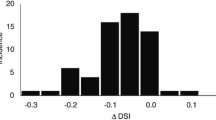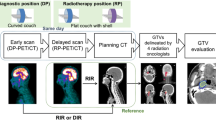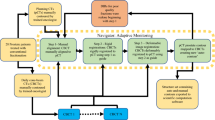Abstract
Background
Clinical application of deformable registration (DIR) of medical images remains limited due to sparse validation of DIR methods in specific situations, e. g. in case of cancer recurrences. In this study the accuracy of DIR for registration of planning CT (pCT) and recurrence CT (rCT) images of head and neck squamous cell carcinoma (HNSCC) patients was evaluated.
Patients and materials
Twenty patients treated with definitive IMRT for HNSCC in 2010–2012 were included. For each patient, a pCT and an rCT scan were used. Median interval between the scans was 8.5 months. One observer manually contoured eight anatomical regions-of-interest (ROI) twice on pCT and once on rCT.
Methods
pCT and rCT images were deformably registered using the open source software elastix. Mean surface distance (MSD) and Dice similarity coefficient (DSC) between contours were used for validation of DIR. A measure for delineation uncertainty was estimated by assessing MSD from the re-delineations of the same ROI on pCT. DIR and manual contouring uncertainties were correlated with tissue volume and rigidity.
Results
MSD varied 1–3 mm for different ROIs for DIR and 1–1.5 mm for re-delineated ROIs performed on pCT. DSC for DIR varied between 0.58 and 0.79 for soft tissues and was 0.79 or higher for bony structures, and correlated with the volumes of ROIs (r = 0.5, p < 0.001) and tissue rigidity (r = 0.54, p < 0.001).
Conclusion
DIR using elastix in HNSCC on planning and recurrence CT scans is feasible; an uncertainty of the method is close to the voxel size length of the planning CT images.
Zusammenfassung
Hintergrund
Die klinische Anwendung der deformierbaren Bildregistrierung (DIR) ist aufgrund geringer Erfahrungswerte in speziellen Situationen noch eingeschränkt (z. B. Karzinomrezidive). Die Studie evaluiert die Treffsicherheit der DIR bei der Registrierung von Planungs-CT-Bildern (pCT) und CT-Scans des Rezidivs (rCT) bei Patienten mit Plattenepithelkarzinomen im Kopf-Hals-Bereich (HNSCC).
Patienten und Methoden
Mithilfe der DIR wurden Planungs-CT und Rezidiv-Scans von 20 HNSCC-Patienten analysiert; alle waren zwischen 2010 und 2012 mit intensitätsmodulierter Strahlentherapie behandelt worden. Das mediane Intervall zwischen den Aufnahmen betrug 8,5 Monate. Jeweils 8 ROI („regions of interest“) wurden auf den pCT- und rCT-Datensätzen manuell definiert. Die Registrierung der Bilder wurde mit der Open Source Software elastix durchgeführt. Zur Beurteilung der Güte der Registrierung wurden MSD („mean surface distance“) und der Dice-Koeffizient (DSC) zwischen den Konturen bestimmt. Um etwaige Unsicherheiten bei der Konturierung abschätzen zu können, wurde der MSD der ROI im pCT als auch in der Wiedereinzeichnung verglichen. DIR und manuelle Konturierungsunsicherheiten wurden mit Gewebsvolumen und -rigidität korreliert.
Ergebnisse
Der MSD liegt zwischen 1–3 mm für verschiedene ROI in der DIR und zwischen 1 und 1,5 mm für wiederholt eingezeichnete ROIs auf dem pCT. Der DSC bei DIR variierte zwischen 0,58 und 0,79 für Weichteilgewebe und war ≥0,79 für knöcherne Strukturen, er korrelierte mit den Volumina der ROI (r = 0,5, p < 0,001) und mit der Gewebsrigidität (r = 0,54, p = 0,001).
Schlussfolgerung
Die deformierbare Bildregistrierung HNSCC-Patienten ist an pCT und rCT durchführbar. Die Methodenunsicherheit liegt in der Größenordnung der Voxelgröße des Planungs-CT.



Similar content being viewed by others
References
Kessler M (2006) Image registration and data fusion in radiation therapy. Br J Radiol 79(Spec No 1):S99–108
Barker JL Jr, Garden AS, Ang KK, O’Daniel JC, Wang H, Court LE, Morrison WH, Rosenthal DI, Chao KSC, Tucker SL, Mohan R, Dong L (2004) Quantification of volumetric and geometric changes occurring during fractionated radiotherapy for head-and-neck cancer using an integrated CT/linear accelerator system. Int J Radiat Oncol Biol Phys 59(4):960–970
Hamming-Vrieze O, Kranen SR van, Beek S van, Heemsbergen W, Herk M van, Brekel MWM van den, Sonke J‑J, Rasch CRN (2012) Evaluation of tumor shape variability in head-and-neck cancer patients over the course of radiation therapy using implanted gold markers. Int J Radiat Oncol 84(2):e201–e207
Mencarelli A, Kranen SR van, Hamming-Vrieze O, Beek S van, Rasch NCR, Herk M van, Sonke J‑J (2014) Deformable image registration for adaptive radiation therapy of head and neck cancer: accuracy and precision in the presence of tumor changes. Int J Radiat Oncol Biol Phys 90(3):680–687
Shakam A, Scrimger R, Liu D, Mohamed M, Parliament M, Field GC, El-Gayed A, Cadman P, Jha N, Warkentin H, Skarsgard D, Zhu Q, Ghosh S (2011) Dose-volume analysis of locoregional recurrences in head and neck IMRT, as determined by deformable registration: A prospective multi-institutional trial. Radiother Oncol 99(2):101–107
http://elastix.isi.uu.nl/. Accessed May 2015
Klein S, Staring M, Murphy K, Viergever MA, Pluim JPW (2010) elastix: A toolbox for intensity-based medical image registration. IEEE Trans Med Imaging 29(1):196–205
Bertelsen A, Schytte T, Bentzen SM, Hansen O, Nielsen M, Brink C (2011) Radiation dose response of normal lung assessed by Cone Beam CT – A potential tool for biologically adaptive radiation therapy. Radiother Oncol 100(3):351–355
Leibfarth S, Mönnich D, Welz S, Siegel C, Schwenzer N, Schmidt H, Zips D, Thorwarth D (2013) A strategy for multimodal deformable image registration to integrate PET/MR into radiotherapy treatment planning. Acta Oncol 52(7):1353–1359
Fortunati V, Verhaart RF, Angeloni F, Lugt A van der, Niessen WJ, Veenland JF, Paulides MM, Walsum T van (2014) Feasibility of multimodal deformable registration for head and neck tumor treatment planning. Int J Radiat Oncol Biol Phys 90(1):85–93
Brink C, Bernchou U, Bertelsen A, Hansen O, Schytte T, Bentzen SM (2014) Locoregional control of non-small cell lung cancer in relation to automated early assessment of tumor regression on cone beam computed tomography. Int J Radiat Oncol Biol Phys 89(4):916–923
Dice LR (1945) Measures of the amount of ecologic assocoation between species. Ecology 26:297–302
Due AK, Vogelius IR, Aznar MC, Bentzen SM, Berthelsen AK, Korreman SS, Kristensen CA, Specht L (2012) Methods for estimating the site of origin of locoregional recurrence in head and neck squamous cell carcinoma. Strahlenther Onkol 188(8):671–676
Brock KK, Velec M, Lee JHM (2014) Validation of Image registration. Image processing in radiation therapy. CRC Press, Boca Raton London New York, pp 41–61
Wang H, Dong L, O’Daniel J, Mohan R, Garden AS, Ang KK, Kuban DA, Bonnen M, Chang JY, Cheung R (2005) Validation of an accelerated “demons” algorithm for deformable image registration in radiation therapy. Phys Med Biol 50(12):2887
Hou J, Guerrero M, Chen W, D’Souza WD (2011) Deformable planning CT to cone-beam CT image registration in head-and-neck cancer. Med Phys 38(4):2088–2094
Mencarelli A, Beek S van, Kranen S van, Rasch C, Herk M van, Sonke J‑J (2012) Validation of deformable registration in head and neck cancer using analysis of variance. Med Phys 39(11):6879–6884
Castadot P, Lee JA, Parraga A, Geets X, Macq B, Grégoire V (2008) Comparison of 12 deformable registration strategies in adaptive radiation therapy for the treatment of head and neck tumors. Radiother Oncol 89(1):1–12
Lawson JD, Schreibmann E, Jani AB, Fox T (2007) Quantitative evaluation of a Cone Beam Computed Tomography (CBCT)-CT deformable image registration method for adaptive radiation therapy. J Appl Clin Med Phys 8(4):2432
Varadhan R, Karangelis G, Krishnan K, Hui S (2013) A framework for deformable image registration validation in radiotherapy clinical applications. J Appl Clin Med Phys / American College of Medical Physics 14(1):4066
Hoffmann C, Krause S, Stoiber EM, Mohr A, Rieken S, Schramm O, Debus J, Sterzing F, Bendl R, Giske K (2014) Accuracy quantification of a deformable image registration tool applied in a clinical setting. J Appl Clin Med Phys 15(1):4564
Acknowledgements
This project was supported by the Region of Southern Denmark, The Danish Cancer Research Foundation, and the Department of Oncology, Odense University Hospital.
Author information
Authors and Affiliations
Corresponding author
Ethics declarations
Conflict of interest
R. Zukauskaite, C. Brink, C.R. Hansen, A. Bertelsen, J. Johansen, C. Grau and J.G. Eriksen state that there are no conflicts of interest.
Ethical standards
The accompanying manuscript does not include studies on humans or animals performed by any of the authors.
Rights and permissions
About this article
Cite this article
Zukauskaite, R., Brink, C., Hansen, C.R. et al. Open source deformable image registration system for treatment planning and recurrence CT scans. Strahlenther Onkol 192, 545–551 (2016). https://doi.org/10.1007/s00066-016-0998-4
Received:
Accepted:
Published:
Issue Date:
DOI: https://doi.org/10.1007/s00066-016-0998-4




